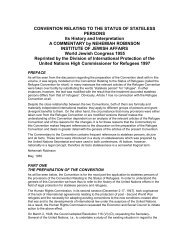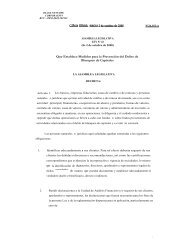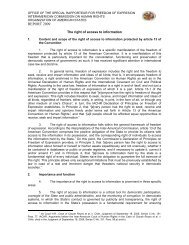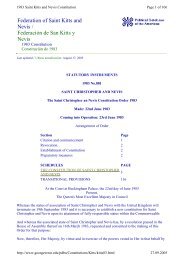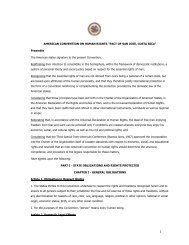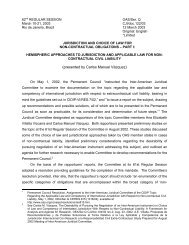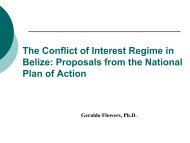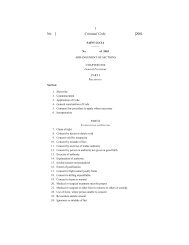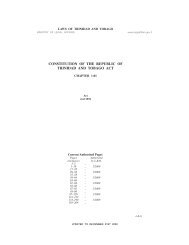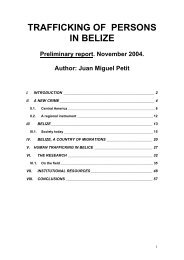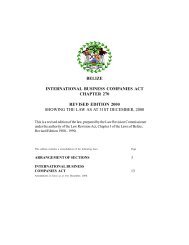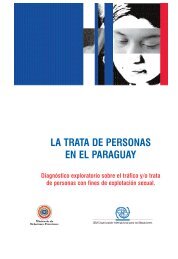(HEMA) Initiative. - OAS
(HEMA) Initiative. - OAS
(HEMA) Initiative. - OAS
You also want an ePaper? Increase the reach of your titles
YUMPU automatically turns print PDFs into web optimized ePapers that Google loves.
PREVIOUS DOCUMENTS Estimating economic benefits of environmental health interventions within the context of the <strong>HEMA</strong> iniciative<br />
twenty-seven key risk factors and their impact on global diseases, mortality and incapacity. Of this<br />
total, six risk factors relate directly to the environment: unsafe water, health and hygiene, urban<br />
air pollution, domestic smoke from solid fuels, exposure to lead, and climate change. 14<br />
Given the myriad ways in which environment and human health interacts, there is a demand for<br />
a clearer understanding of the linkages between environment and health, particularly involving<br />
the interaction of poverty, exposure to environmental risks in slums and land zoning in the urban<br />
periphery; and a regulatory intervention designed to reduce environmental degradation that<br />
poses measurable human health hazards, and the resulting impact on the economy. The environmental<br />
health policies envisaged in the <strong>HEMA</strong> initiative demand a multi-disciplinary approach,<br />
that is, coherence not only among health and environmental officials, but also engineers, those<br />
responsible for zoning, poverty alleviation efforts, architects, economists and others. 15 Integrating<br />
health and environment remains conceptually clear, but operationally difficult.<br />
Environmental risk transition<br />
According to an analysis by the World Health Organization, in today's world a transition is taking place in environmental<br />
health risks from traditional risks related to the impact of natural phenomena and insufficient development, to modern<br />
risks associated with some features of unsustainable development. In general, developing countries are exposed to both<br />
traditional and modern risks. Traditional risks are usually a consequence of poverty or of exclusion from the benefits of<br />
development, such as lack of access to drinking water, inadequate disposal of excrements, domestic air pollution<br />
caused by dust, fungi and smoke from burning fossil fuels for cooking and lighting, contamination of food with pathogenic<br />
substances, exposure to the impact of drought, floods and earthquakes, contamination with lead from ceramics and<br />
paints, and accidents or illnesses caused by small-scale or artisanal agriculture and industry. Modern risks mostly originate<br />
in industrial processes without sufficient safeguards to prevent or mitigate sanitary and related environmental problems.<br />
They include such dangers as accumulation of hazardous solid waste; air pollution from industrial or vehicular emissions in<br />
urban zones; pollution of water resources with industrial or agricultural waste and urban sewage; the improper handling<br />
of chemical or radioactive substances used in new agricultural or industrial technologies; traffic accidents; emerging or<br />
reemerging infectious diseases; climate and atmospheric changes (such as depletion of the ozone layer and the greenhouse<br />
effect); violence or other psychological effects of the urban environment; and the abuse of drugs such as tobacco and<br />
alcohol. In general terms, traditional and modern risks come from activities that are harmful to health because of the<br />
concentration of emissions in the air, water, soils or food.<br />
Source: United Nations Environment Programme (UNEP) and Universidad de Costa Rica-Observatorio del Desarrollo (UCR-OdD) (2004),<br />
GEO-Latin America and the Caribbean: Environment Outlook 2003 (Costa Rica: Master Litho S.A.).<br />
SECTION II - OVERVIEW OF METHODOLOGICAL APPROACHES<br />
Numerous methodological challenges are associated with quantifying in economic terms various<br />
environmental health linkages. Before outlining some of these challenges, it is worth noting in<br />
general that economic benefits associated with regulatory or policy interventions are systematically<br />
undervalued. Although the direct cost burden of environmental regulations is fairly well understood,<br />
the extent, distribution and long-term repercussion of environmental health benefits are by definition<br />
diffusive and largely indirect.<br />
General considerations that estimate the direct savings and related welfare benefits of environmental<br />
health interventions include:<br />
• Savings in costs of curative and preventive care (reduction in disease cases that would have<br />
been treated - costs of treatment per case).<br />
• Gains in production of cases averted (work days increased - value of average day not worked).<br />
• Gains in production of deaths averted (work years increased - discounted value of average<br />
income per year). 16<br />
Meeting of Ministers of Health and Environment of the Americas | 45




